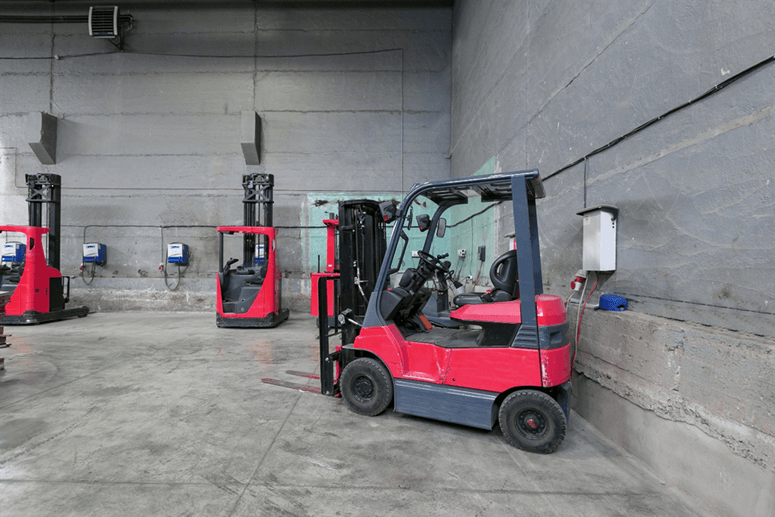As companies look for opportunities to reduce carbon emissions while lowering costs, industrial and commercial businesses are rethinking how they use energy. From manufacturing processes and machinery to company fleet vehicles – electrification is transforming fundamental business operations.
Businesses, governments and institutions can reap operational benefits and lower energy bills by replacing traditional fossil-fueled equipment and vehicles with versions powered by electricity.
Fleet Vehicles
Fleet owners are particularly interested in electric cars because the total cost of ownership is significantly less considering the maintenance and fuel. From on-road buses, garbage trucks and emergency response vehicles to non-road transportation such as heavy-duty trucks for factories, distribution centers, marine ports and airports – companies are going electric.
The biggest reason companies are switching their fleet vehicles to electric? Cost savings. While gas prices are volatile, electricity rates are regulated and stable. Some utilities even offer lower, off-peak rates, which means companies can save even more when they recharge their fleets during off-peak hours.
Cost savings go beyond just fuel. Electric cars require virtually no maintenance. They don’t need oil changes, transmission fluid, fan belts, air filters, serpentine belts, head gaskets, cylinder heads, spark plugs, exhaust systems, starter motors or fuel injection systems. The brakes last longer because of regenerative braking. In fact, an electric car motor has only one moving part: the rotor. That’s why most electric cars now have the same powertrain warranties as gas cars. Electric cars eliminate virtually all routine and maintenance items for fleets — while reducing parts inventories, labor costs and car downtime.
Electric Forklifts
Today, electric forklifts are outselling fossil-fuel-powered forklifts (LPG, diesel or gasoline) 64% to 36% — with the fastest growth coming from heavy-duty, indoor/outdoor 90–120 volt electric forklifts that didn’t even exist 10 years ago. Not only is electricity the lowest-cost fuel for vehicles, companies can also take advantage of lower electric rates if they recharge during off-peak hours – 9 p.m. to 7 a.m.

By moving to an all-electric fleet, companies can simplify their operations. There’s no need to maintain on-site fuel storage and refueling. And for their operators, it’s a lot easier — and safer — to plug a forklift into a charger than to refuel their tanks with gas.
Another major cost savings comes from the lower maintenance costs of electric forklifts. Because fossil-fuel- powered forklifts have more moving parts than electrics, as well as lubricants and filters to replace, they typically require twice as much maintenance. With more frequent routine maintenance, and more time required for each check-up, the total scheduled maintenance costs can be three times higher — or more — than for an electric. In a typical plant, that’s an extra $1,500 in maintenance costs per forklift.
Manufacturing Processes and Equipment
As efficient and reliable manufacturing and material handling equipment becomes more widely available, companies are leveraging electric technologies to reduce emissions and operational costs.
For example, metal-working industries are switching to induction heating technology which provides numerous benefits, including quicker heating (up to 10 times faster), more precise temperature control, elimination of gas heat and emissions and major cost savings. The overall annual costs of electric induction surface treatments are up to 80% lower than using gas furnaces.
Improving the quality of manufacturing process is another key advantage for many companies. While gas ovens have traditionally been used to cure coatings and paints, the transition to water-based organic coatings and newer spray-on, electrostatic powders has resulted in the need for technologies that can properly cure these coatings. Electric infrared curing and drying heaters vastly improve the quality and performance of these types of finished coatings by matching the wavelength to the absorption characteristics of the coating. In addition, electric infrared curing and drying heaters are twice as fast, more efficient and smaller than traditional gas convection ovens.
Heating
Looking to reduce your building’s environmental impact and overall energy use? The adoption of geothermal heat pumps has seen an increase as companies are exploring new ways to become more environmentally friendly while lowering expenses related to heating and cooling. In fact, Oklahoma uses geothermal heat pumps to heat and cool its state capitol.
Geothermal heat pumps (also known as ground source heat pumps) use the constant temperature of the surface of the earth to transfer heat from the ground (or water) into buildings during the winter and reverse the process in the summer. Since underground temperatures are more constant than outdoor temperatures, a geothermal heat pump is reliable and efficient all year long.
In addition to the more efficient heating and cooling, geothermal heat pumps typically require less maintenance, which means more savings and a better return on investment. PSO also provides substantial rebates for companies looking to install these systems. See how a local Tulsa business saved over $20,000 on a geothermal upgrade.
